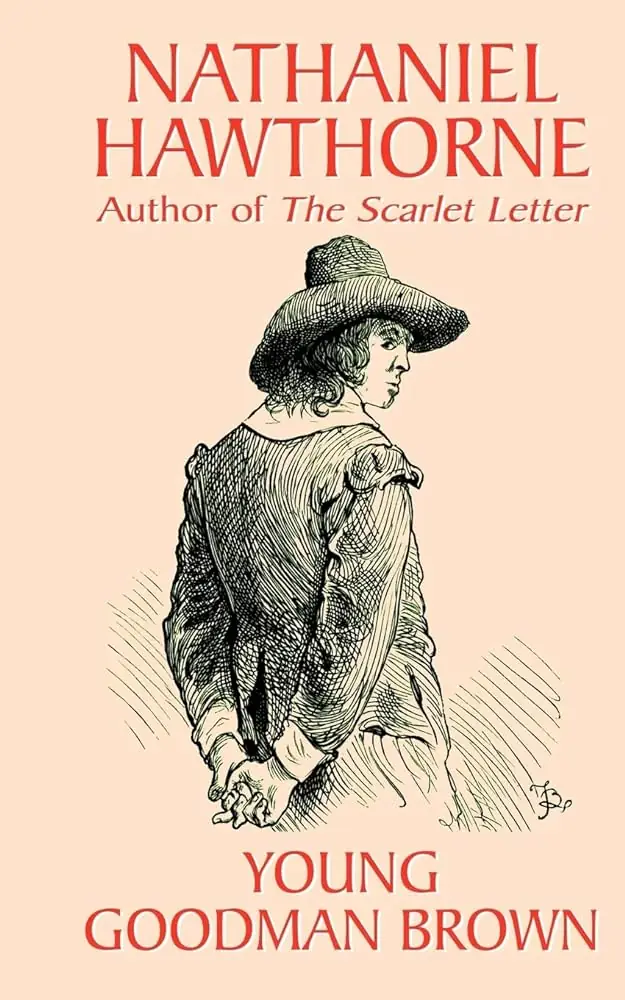“Young Goodman Brown” is a short story written by Nathaniel Hawthorne, first published in 1835. Set in 17th century Puritan New England, this narrative delves into themes of innocence, evil, and the duality of human nature through the protagonist’s surreal and ominous journey into the woods.

✅ AI Essay Writer ✅ AI Detector ✅ Plagchecker ✅ Paraphraser
✅ Summarizer ✅ Citation Generator
Overview
The story centers on Young Goodman Brown, a newly married Puritan man, who leaves his wife, Faith, to undertake a mysterious errand that takes him into the forest at night, a place believed to be fraught with evil. As he ventures deeper into the woods, Goodman Brown encounters various townspeople engaged in devilish rites, leading him to question the righteousness of those he once respected and the very nature of humanity.
Plot Summary
Young Goodman Brown sets out from his home in Salem village one evening, despite the pleas from his wife, Faith, to stay with her. He ventures into the forest on an ambiguous errand that soon reveals a darker purpose: a meeting with the Devil himself.
In the forest, Goodman Brown meets an older man who resembles him and seems to be expecting him. This man carries a staff that resembles a great black serpent, suggesting his association with the devil. As they walk together, they encounter respected members of the community, revealing the hypocrisy and secret sins of the people Goodman Brown had believed to be virtuous.
Eventually, they reach a clearing where a satanic ritual is about to take place. The townspeople are assembled, and Goodman Brown sees figures from all walks of life, including religious leaders and his own wife, Faith. As the ceremony progresses, Goodman Brown is urged to join them and renounce his faith. At the last moment, he resists, crying out to Faith to resist as well.
Goodman Brown awakens in the forest at dawn, unsure whether the previous night’s events were real or a dream. However, the experience irrevocably changes him. He returns to Salem a disillusioned man, seeing sin everywhere and trusting no one. This cynicism pervades the rest of his life, affecting his relationships and his faith. He dies a bitter and lonely man, “and his dying hour was gloom.”

Insights
“Young Goodman Brown” explores the inherent evil and hypocrisy that Hawthorne perceived in human nature, particularly within the context of Puritanical piety. The story challenges the notion of inherent human goodness and underscores the potential for wickedness in everyone. It also examines the impact of disillusionment and loss of faith, both in religion and in humanity, highlighting how such a loss can taint one’s perspective on life.
Notable Quotes
- “Evil is the nature of mankind. Evil must be your only happiness. Welcome again, my children, to the communion of your race.”
- “The fiend in his own shape is less hideous than when he rages in the breast of man.”
Similar Books
Readers who appreciate the themes in “Young Goodman Brown” might also enjoy:
- “The Scarlet Letter” by Nathaniel Hawthorne – Another exploration of sin, guilt, and hypocrisy in a Puritanical setting.
- “The Minister’s Black Veil” by Nathaniel Hawthorne – A short story that delves into themes of secret sin and the nature of human isolation and alienation.
- “The Crucible” by Arthur Miller – A play that, while focused on the Salem witch trials, explores similar themes of hysteria, morality, and societal judgment.
- “The Fall of the House of Usher” by Edgar Allan Poe – A story that explores themes of madness, family, and metaphysical identities in a gothic setting.
“Young Goodman Brown” remains a powerful and thought-provoking tale that continues to resonate with readers for its profound insights into the complexities of moral and spiritual life.
Follow us on Reddit for more insights and updates.






Comments (0)
Welcome to A*Help comments!
We’re all about debate and discussion at A*Help.
We value the diverse opinions of users, so you may find points of view that you don’t agree with. And that’s cool. However, there are certain things we’re not OK with: attempts to manipulate our data in any way, for example, or the posting of discriminative, offensive, hateful, or disparaging material.